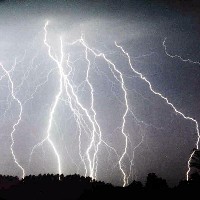 A meteorologist at Texas A&M University in College Station developed an enhanced lightning detection system for the Houston region, one of the most lightning-prone areas in the U.S. Richard Orville, an atmospheric sciences professor, led the $1.2 million project, which was funded by National Science Foundation.
A meteorologist at Texas A&M University in College Station developed an enhanced lightning detection system for the Houston region, one of the most lightning-prone areas in the U.S. Richard Orville, an atmospheric sciences professor, led the $1.2 million project, which was funded by National Science Foundation.
Houston averages some 1,700 lightning strikes in the months of June and July alone, says Orville, at a density of about 20 strikes per square mile. “You need two things for lightning to occur, heat and moisture,” notes Orville, “and Houston has plenty of both.”
The system, known as Lightning Mapping Array, reads data from 10 sensors around Houston and the immediate vicinity, as well as two more sensors placed in Brazos County and Galveston, Texas. The sensors record the precise time of a lightning flash and associated data of the event. Those data are then fed into a central server on the university campus.
The new system allows Orville and colleagues to calculate the precise latitude and longitude from where the lightning originated, and provide advance warning of 5 to 20 minutes of the next cloud-to ground strike. The system uses solar panels for power and has Wi-Fi links to transmit the data more efficiently.
Orville led the research in the 1980s that became the National Lightning Detection Network in the U.S. That system, installed in 48 states and Canada, detects every ground strike of lightning.
The National Weather Service says about 60 people are killed each year by lightning, making it the second-greatest weather killer, after floods. So far, 10 lightning fatalities were recorded this year in the U.S., including one in Texas.
Photo: Les Chatfield/Flickr
Read more:
- Smart Wall Panel Designed to Give Seniors Day-to-Day Help
- Addition of Lightning Data Increases Tornado Warning Times
- Study: Insurance Industry Adjusting to Climate Change
- Methods Developed to Detect, Remove Ice from Aircraft Wings
- Grant to Fund New Program Logic for Flight Data Integration
* * *

 RSS - Posts
RSS - Posts
You must be logged in to post a comment.